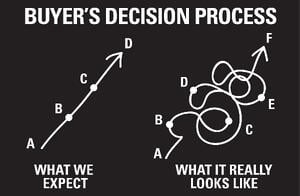Is Drifting Hard
Marketing is hard. But the problem is that too many people think it isn't. Especially with all the new, "magic bullet" technologies out there that pretty much do everything for you. So where are the results? Why, asks your CEO, did we miss our numbers again? The fundamental challenge of marketing is that there are a zillion moving parts, give or take, courtesy of a shape-shifting buyer who makes Jell-O look like bedrock. The buyer's journey, which is most often defined as an orderly march down a funnel-shaped thing, is more often beset by a range of shiny objects, conflicting egos, power grabs, FUD (fear, uncertainty, doubt), budget shifts, priority shifts, urgent and important fires to extinguish, as well as various other threats to goals and timelines that show up daily in our businesses. In short, stuff happens. So if that's all true, if buyers cannot be relied upon to respect the very deliberate path we set out before them, what can we do to improve our conversion rates from prospects to leads and leads to customers? We can start by better understanding the Math of the Besieged Buyer that looks something like this: The chart above comes from something I call the Rule of 30-20-10. This rule is a simplified version of several "rules" from the world of direct response that have proven very robust over the decades (including current times) when it comes to predicting how buyers behave. (If you want to dig deeper, see Rule of 45, and the Advertising Research Foundation studies via Bob Stone.) There's a certain instinctive truth to the above chart. Of course, it's not perfectly predictive, but it does provide good directional information to create some context around this discussion. So we run a series of campaigns, and what happens? Taking our Math of the Besieged Buyer one step further, we might get: If you consider the number of "wins" on the bottom line, you get an eye-opening look at the slippage that can occur in any marketing system. Importantly, it's not the software you may or may not be using that causes the majority of this slippage. As discussed in an earlier post, it's the work that you put in prior to going to market. I was speaking with a colleague this week who has carved out a very successful marketing automation consultancy. He deals with all sizes of company, up to the very large and, presumably, sophisticated. The common feature that continues to amaze him is how impatient marketing organizations are. "Get it out" consistently trumps "do it right." Everyone is looking for shortcuts, and few are putting in the critical thinking that addresses the kinds of slippage observed above. Precision targeting often falls victim to "buy a large list and blast it" [note 1 above]. The breakthrough that comes from a well-conceived and tested value proposition is more often lacking than not [note 2 above]. The buyer consideration that results from offers that are constructed from truly compelling content is almost always in severe deficit [note 3 above]. The usual suspects of marketing slippage -- targeting, value proposition, and offer strategy -- continue to be shortchanged by marketers who are consumed by the delicious intricacies of execution at the expense of the hard work of thoughtful strategy. Marketing is hard. But it's made even more so when we forget that in-the-trenches patience and persistence will always score more touchdowns on the marketing gridiron (ugh) than ivory-tower hunches and hubris. Drew Williams is a serial marketing entrepreneur and co-author of Feed the Startup Beast: A 7 Step Guide to Big, Hairy, Outrageous Sales Growth (McGraw-Hill 2013). Drew shares his beast-building ideas atFeedTheBeast.biz/blog and @FeedYourBeast.  A version of this post originally appeared on the Opinion section of Inbound Hub. To read more content like this, subscribe to Opinion here.
A version of this post originally appeared on the Opinion section of Inbound Hub. To read more content like this, subscribe to Opinion here. 

Patience Is a Virtue, Even in Marketing

Originally published Feb 17, 2014 1:00:00 PM, updated February 01 2017
Source: https://blog.hubspot.com/marketing/why-marketing-is-so-hard

0 Komentar